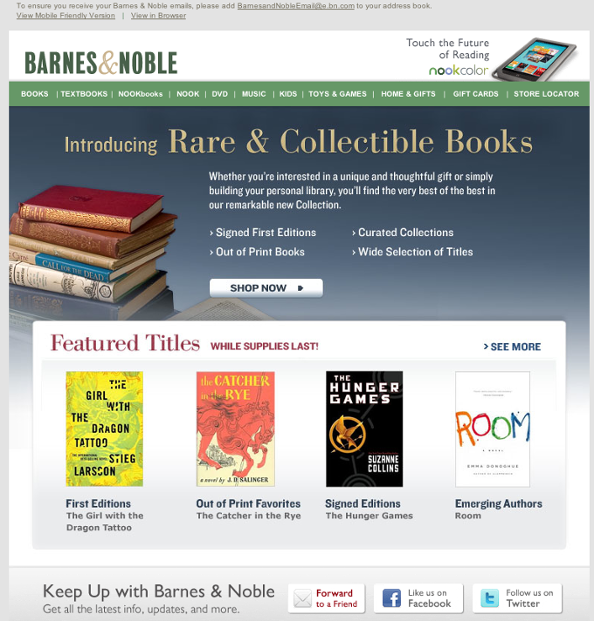It’s awfully hard to know what goes on inside someones email campaigns because we don’t know their email marketing statistics.
We don’t know their normal open rates, click rates, and sales numbers so when we look at an email newsletter format and copy, we may point out issues but it may be a home run for them because they made a particular tweak to improve results.
Nevertheless, there are things to be learned from other people’s email newsletters and I’d like to have you look at this enewsletter I received from Barnes & Noble a few weeks back.

OK, here are some points for you to think about and see if they apply to you.
1. Call to Action. It’s important for your email to have a clear call to action. It gives you a reason to write and send the email and something to measure to see if your email is working as planned.
This email uses what I call the kitchen sink method of clickable items. I see about 20 places you can click on this email to go somewhere on their site. Here’s the trick, if 20 clickable items is good, is 30 better? How about 50? What about 5? What about one or two specific ones?
You see an email is different than most web pages. In an email you are taking the page to them. On a web page they come to you.
When you take something to them you don’t show up and say, ‘Click on any of these 20 things that interest you’ You say ‘Here’s something of value to you, click here to find out more’
See the difference?
I take it from the headline in this message they are trying to reach people who are interested in rare and collectable books.
2. Content for real people. So if you are targeting people interested in rare and collectable books and this email reaches one of them, you might want your copy to be very focused on that topic.
To me that means perhaps less hints about the nook (how do you collect a rare book on a nook?) and more about rare books. In my mind this message could have done with less images and more about the real reason Barnes & Noble has something to say in the rare book space (it was total news to me).
Just keep in mind you are writing to one audience at a time.
3. Target your mailings. This message looks like it went to the general B&N newsletter list. If that’s the case, then it should be trying to either a) find BN subscribers who are already rare book buyers, or b) convert regular book buyers into collectible book buyers.
With that in mind, do you think it does either?
I’d rate this perhaps a D because of these misses. Take a moment to think about your mailings. Are they targeted properly? Is your copy compelling? Do you have a clear call to action?
